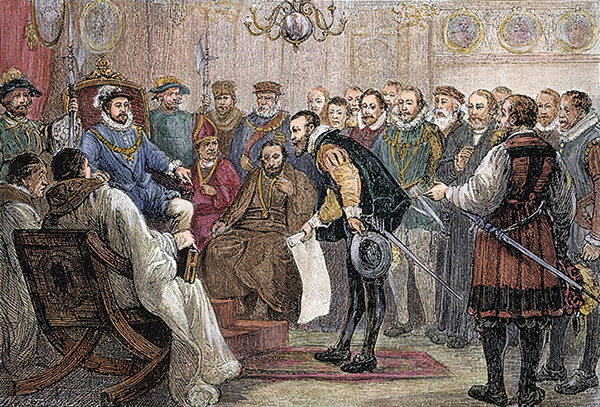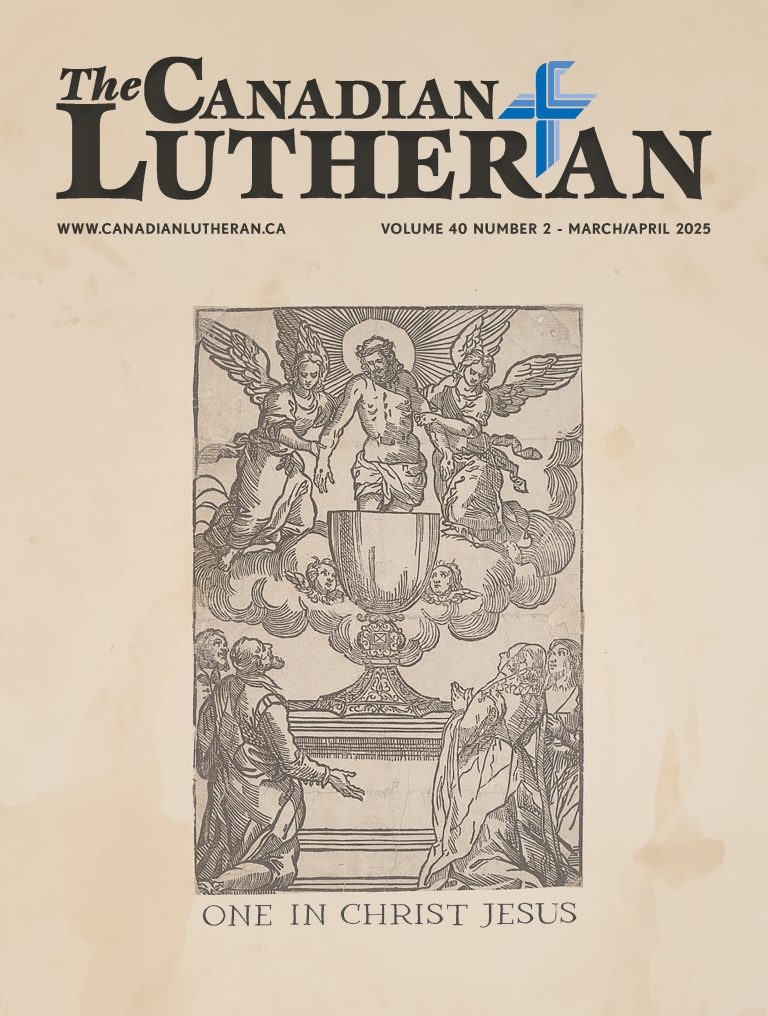History of the Reformation: The Augsburg Confession

The presentation of the Augsburg Confession (19th century illustration).
by Mathew Block
Reformation commemorations are often tied to October 31, the date when tradition states Martin Luther nailed the 95 Theses to that church door in Wittenberg. But in many ways, a better case could be made for celebrating it on June 25, the presentation-date of the Augsburg Confession.
Emperor Charles V had invited the electors of Germany to Augsburg for an imperial Diet to begin April 1530. John the Steadfast, elector of Saxony since the death of his brother Frederick the Wise in 1525, saw this as an opportunity to solidify the position of the Evangelicals. He therefore instructed Martin Luther, Philip Melanchthon, Johannes Bugenhagen, and Justas Jonas to meet in Torgau to draw up a statement of faith.
From there, they travelled with John the Steadfast to Augsburg. Luther, of course, was unable to go the whole way: the Emperor had declared him an outlaw at the 1521 imperial Diet in Worms. He therefore stayed behind in Coburg, while his coworker Philip Melanchthon took the lead as theological adviser to the German princes.
It was a wise decision. Luther was, by his own admission, rather severe in tone, while Melanchthon was irenic. “I am born to make war upon hordes and devils, and to take the field, and therefore my books are stormy and warlike,” Luther notes. “But Philip comes quietly and soberly afterwards, cultivating and planting, sowing and watering the seed joyfully, God having given him such gifts in abundance.”
Melanchthon’s gentleness did not mean he was a push-over in matters of theology though. It was Melanchthon after all, not Luther, who wrote the first systematic theology of the reformation, The Loci Communes. Of this book, Luther later wrote: “There is no work in which theology is better summarized… After the Scriptures, it is the most perfect of books.”
This pairing—gentleness with theological acumen—made Melanchthon a natural choice to articulate the faith of the Lutheran movement. So it is that he composed the Augsburg Confession, drawing on articles the reformers had drafted together at Torgau, as well as at earlier conferences. Luther provided suggestion and correction through correspondence. Justas Jonas also provided helpful advice. Melanchthon even sought feedback from representatives of the Roman party: the moderate Bishop of Augsburg Christoph von Stadion, for example, and the imperial secretary Alfonso de Valdés.
By June 23, Melanchthon had completed the final text. John the Steadfast, along with six other German rulers and the representatives of two free German cities, signed the document, and it was publicly read before the emperor on June 25, 1530.
From afar Luther praised the Augsburg Confession for its steadfastness and gentle tone. “I rejoice beyond measure that I lived to see the hour in which Christ publicly glorified by such great confessors, in so great an assembly, through this in every respect most beautiful Confession,” he writes. “I only regret that I was not able to be present when this splendid Confession was made.”
I rejoice beyond measure that I lived to see the hour in which Christ publicly glorified by such great confessors, in so great an assembly, through this in every respect most beautiful Confession.
In the Augsburg Confession, Melanchthon took pains to articulate the conservative nature of the Lutheran Reformation. For that reason, 21 of the 28 articles are concerned with demonstrating the orthodoxy of the movement in relation to the Church throughout history. These articles of faith cover various topics, ranging from the Trinity, to justification, to the nature of the Church, to the sacraments, and more.
At the conclusion of this section, Melanchthon summarizes the faith as follows: “As can be seen, there is nothing [here] that varies from the Scriptures, or from the Church universal, or from the Church of Rome, as known from its writers.” He writes again: “Our churches do not dissent from any article of the faith held by the Church catholic.”
Only after establishing this fundamental agreement between the historic Church and the Lutheran faith does Melanchthon turn to “newer abuses” that have “crept into the Church without rightful authority.” The remaining articles detail the Lutheran position on seven issues, arguing, for example, that the laity should receive both bread and wine during communion, and that priests should be allowed to marry. It also critiques abuses on the Mass, confession, fasting, monastic vows, and church authority.
“We have mentioned only those things we thought it was necessary to discuss so that it would be understood that in doctrine and ceremonies we have received nothing contrary to Scripture or the Church universal,” Melanchthon writes in conclusion.
By demonstrating common theological ground with their theological opponents, Melanchthon hoped to foster reconciliation. “We… are prepared to discuss, in a friendly manner, all possible ways and means by which we may come together,” he writes in the preface to the confession. “This can be done honourably, with God’s help, so that we may be brought back to agreement and concord.”
No such reconciliation was forthcoming. The emperor appointed a committee—prominent among them Luther’s old opponent, Johann von Eck—to “confute” the Lutheran confession. The emperor rejected the first attempt for its vitriol, spurious accusations, and failure to actually engage the teachings of the Augsburg Confession. A more restrained version of the Confutation was eventually accepted and read publicly at the Diet on August 3, 1530. In response, Melanchthon composed the Apology to the Augsburg Confession. While it was not read during the Diet, it was nevertheless accepted by Lutherans as a richer explication of the faith first presented at Augsburg. The lines were now more clearly drawn.
As a clear and winsome expression of the Lutheran faith, the Augsburg Confession remains to this day the most important document of the Reformation period. It stands first among equals in the Symbols of the Lutheran Church, calling us all to greater allegiance to the truth and teachings of God’s Word.
As an overture towards healing the breach in the church, the Augsburg Confession failed. But as a clear and winsome expression of the Lutheran faith, the Augsburg Confession remains to this day the most important document of the Reformation period. It stands first among equals in the Symbols of the Lutheran Church, calling us all to greater allegiance to the truth and teachings of God’s Word.
———————
Mathew Block is communications manager of Lutheran Church–Canada (LCC) and editor of The Canadian Lutheran magazine. He is also editor of the book Saints of the Reformation, published by LCC to mark the 500th anniversary of the Reformation.
This is part five in a six-part series on the History of the Reformation. Find all the currently published articles here.




